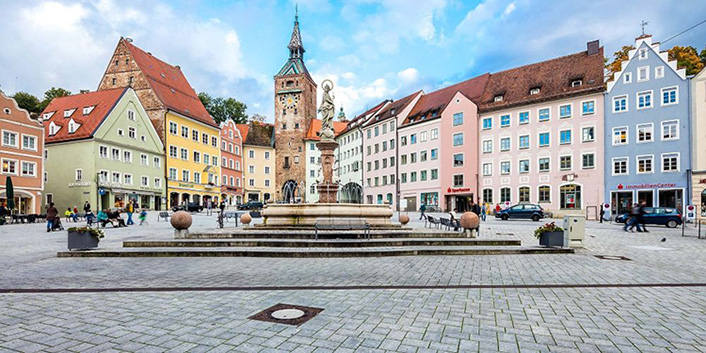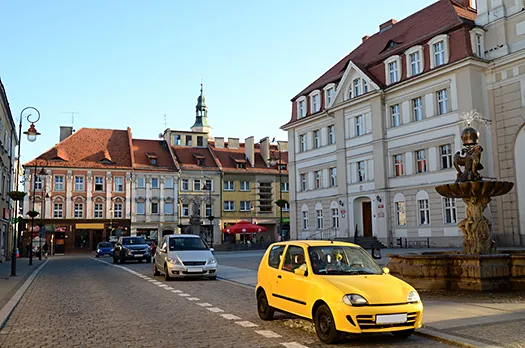LANDSBERG AM LECH bus to PRUDNIK
LANDSBERG AM LECH

Landsberg am Lech is a city in southern Germany, located in Bavaria, on the Lech River, about 50 km west of Munich. It is a historic city that played an important role in both medieval and modern German history.
Landsberg am Lech is a medieval town that has retained much of its historic buildings. Highlights include:
1. Old Town - With its preserved medieval streets, churches and townhouses, Landsberg's Old Town has a unique charm. Take a walk through the narrow streets and see the townhouses from the Renaissance and Baroque periods.
2. Landsberg Castle - The 13th century castle, which is one of the focal points of the city. The castle is an excellent example of medieval martial architecture.
3. Church of St. John the Baptist - An impressive church from the 15th century, which is one of the most important religious monuments in the city. It has a beautiful interior with works of art from various historical periods.
4. Lech Tower - A medieval defense tower that is one of the symbols of the city. The tower offers a beautiful view of the surrounding countryside.
5. Landsberg Prison Monument - During World War II, Landsberg was home to a prison that held many high-ranking Nazis, including Adolf Eichmann, as well as other war criminals. Today there is a memorial on the site of the former prison to commemorate these events.
Today Landsberg am Lech is a city of about 30,000 residents that has retained much of its traditions and historical charm, but is also modernizing in terms of infrastructure and economy. The city is a popular tourist destination, especially for those interested in history and medieval architecture.
The city is also known for hosting a variety of festivals and cultural events that attract tourists and locals. In addition, Landsberg is well connected to Munich and other major cities, making it a good place to live and work, with proximity to major industrial and cultural centers.
Landsberg am Lech is a city in southern Germany, located in Bavaria, on the Lech River, about 50 km west of Munich. It is a historic city that played an important role in both medieval and modern German history.
Landsberg am Lech is a medieval town that has retained much of its historic buildings. Highlights include:
1. Old Town - With its preserved medieval streets, churches and townhouses, Landsberg's Old Town has a unique charm. Take a walk through the narrow streets and see the townhouses from the Renaissance and Baroque periods.
2. Landsberg Castle - The 13th century castle, which is one of the focal points of the city. The castle is an excellent example of medieval martial architecture.
3. Church of St. John the Baptist - An impressive church from the 15th century, which is one of the most important religious monuments in the city. It has a beautiful interior with works of art from various historical periods.
4. Lech Tower - A medieval defense tower that is one of the symbols of the city. The tower offers a beautiful view of the surrounding countryside.
5. Landsberg Prison Monument - During World War II, Landsberg was home to a prison that held many high-ranking Nazis, including Adolf Eichmann, as well as other war criminals. Today there is a memorial on the site of the former prison to commemorate these events.
Today Landsberg am Lech is a city of about 30,000 residents that has retained much of its traditions and historical charm, but is also modernizing in terms of infrastructure and economy. The city is a popular tourist destination, especially for those interested in history and medieval architecture.
The city is also known for hosting a variety of festivals and cultural events that attract tourists and locals. In addition, Landsberg is well connected to Munich and other major cities, making it a good place to live and work, with proximity to major industrial and cultural centers.
PRUDNIK

Prudnik is a small town in Opole province, historically part of Upper Silesia. The rivers Prudnik and Zloty Potok flow through it. It is only 5.5 kilometers from the Czech border.
This medieval town was granted city rights in 1279. The only monument, so to speak, remembering those times is the castle tower (Woka Tower), the oldest tower of its kind in Upper Silesia, from which one can admire the panorama of the city and its immediate surroundings.
Prudnik was not heavily damaged during World War II, so it reflects well the atmosphere of the historic city. Worth seeing is Prudnik's rectangular market square with colorful 18th- and 19th-century townhouses. In its central part is the town hall with a tall tower, and some of the older buildings in the city - the Marian column and the statue of St. John Nepomucen.
Around the city, due to the nearby location of the Opawskie Mountains, one can also find many walking and hiking trails, and in nearby Prudnik-Les there is a well-known Franciscan monastery along with the St. Joseph's sanctuary, where Cardinal Stefan Wyszynski was imprisoned in 1954.
Prudnik - how to get there
Prudnik is crisscrossed by national and provincial roads. The city is fairly well connected with its nearest neighbors and is located
on the route leading to the Trzebina-Vysoká border crossing with the Czech Republic.
The town also has a railway station and the Prudnik PKS bus station with frequent buses. Numerous connections to Polish and European cities depart from the bus station. If you have never been to Prudnik, but are planning a vacation in the Opawskie Mountains area, for example, visit this town as well - it will surely charm you.
Prudnik is a small town in Opole province, historically part of Upper Silesia. The rivers Prudnik and Zloty Potok flow through it. It is only 5.5 kilometers from the Czech border.
This medieval town was granted city rights in 1279. The only monument, so to speak, remembering those times is the castle tower (Woka Tower), the oldest tower of its kind in Upper Silesia, from which one can admire the panorama of the city and its immediate surroundings.
Prudnik was not heavily damaged during World War II, so it reflects well the atmosphere of the historic city. Worth seeing is Prudnik's rectangular market square with colorful 18th- and 19th-century townhouses. In its central part is the town hall with a tall tower, and some of the older buildings in the city - the Marian column and the statue of St. John Nepomucen.
Around the city, due to the nearby location of the Opawskie Mountains, one can also find many walking and hiking trails, and in nearby Prudnik-Les there is a well-known Franciscan monastery along with the St. Joseph's sanctuary, where Cardinal Stefan Wyszynski was imprisoned in 1954.
Prudnik - how to get there
Prudnik is crisscrossed by national and provincial roads. The city is fairly well connected with its nearest neighbors and is located
on the route leading to the Trzebina-Vysoká border crossing with the Czech Republic.
The town also has a railway station and the Prudnik PKS bus station with frequent buses. Numerous connections to Polish and European cities depart from the bus station. If you have never been to Prudnik, but are planning a vacation in the Opawskie Mountains area, for example, visit this town as well - it will surely charm you.
© 2025 Sindbad
Technical support, assistance, payments: Sindbad IT
© 2025 Sindbad
Technical support, assistance, payments: Sindbad IT
